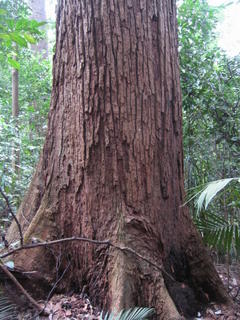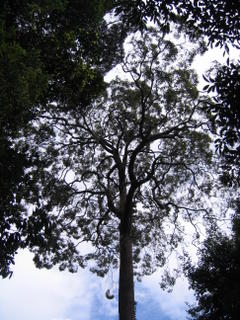To kick off our series, we introduce Shorea curtisii, otherwise commonly known as Seraya. Yep, that's the Shorcu that was talking to you in this blog's inaugural post on April 1st. SHORCU is our short code for the tree's full name. If you're taking a walk in the trails on a weekday and hear someone shout "SHORCU!", that's us at work in the reserve, identifying a Shorea curtisii.
We're about one-fifth our way through the Bukit Timah Nature Reserve, and already, the Seraya tops our list as one of the most abundant species at the reserve. The species is distributed on Hill Dipterocarp Forest throughout the Malay Peninsula, from Thailand to Singapore. In Bukit Timah Nature Reserve, the tree is very common throughout, and very particularly so along Jungle Fall path off from the Main road.
The Seraya is a majestic tree that is relatively easy to identify. To spot this common tree, look for the following characteristics:
- They are large trees, easily over 30cm in diameter, and we have measured many reaching over 100 cm in diameter.
- Their trunks are usually well-shaped and round, can be grey or reddish-brown, and are characteristically coarsely-fissured, though this may not be so obvious in younger trees (picture akan datang).
- The tree crown is light-coloured and appears greyish-green (Due to the fact that the underside of the leaves are mostly glaucous - see below) . The leaves also grow in small clusters on the branches, and dangling down like small umbrellas.
- Their leaves are hairless and smooth. They are normally lanceolate (lance-shaped) or elliptic, acuminate (with an acute tip), and about 10cm by 4cm in size (leaves are bigger on younger/lower branches or on young trees). Leaves on higher branches of a mature big tree usually have their upper surface covered with a glaucous bloom while their lower surface pale silvery or yellow glaucescent (not so glacous) - giving it a distinct greyish-blue appearance on the canopy.The leaf stalk is slender and about 2.5cm long, and is often bent in leaves that have dropped. The primary and secondary nerves are clearly visible. There are about 10-18 secondary nerves, roughly parallel but curving upwards to the tip at the leaf blade. The tertiary nerves are fainter but still visible, and are ladder-like. (to understand these it's better to have some leaves in your hands :p)
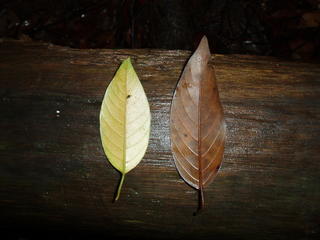
- Flowers are small, about 1.5cm across, with 5 petals and 15 stamens, white to pale yellow in colour. (You don't see them every year... And when they fall it's like snowing in the forest!)
- The fruits are winged, like a shuttlecock. There are 3 large wings and 2 short wings, surrounding the nut, the entire fruit about 6 cm from wing tip to nut when ripe. The wings turn red even before ripening. The Shoreas in the reserve are currently fruiting, and their fruits can be seen scattered liberally all over the reserve. This happens very rarely, about once every 5-10 years, so do come down to check our the Shoreas' winged fruits!
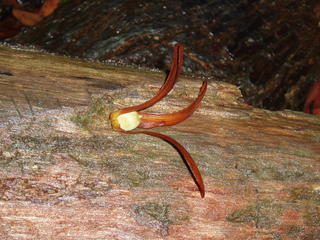
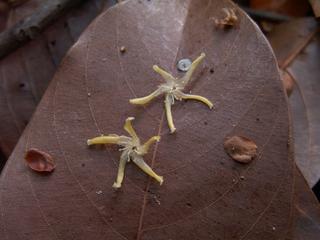
Other interesting facts about the Seraya:
- Seraya has many other relatives in our reserve, for example Meranti Tembaga (Shorea leprosula), Melantai (Shorea macroptera), Nemesu (Shorea pauciflora) and Meranti Sarang Punai (Shorea parvifolia) . These Shoreas belong to the group of Red Meranti, Their woods are light-weight, durable and highly valued! (Seraya's wood is suitable for making furniture, interior finishing, flooring, panelling, doors and veneers)
- Being one of the tallest trees on Bukit Timah, Seraya often fall victim to thunderstorm and lightnings! You may see some big fallen Serayas along the main road to summit :'(
- Their growth-form can be so variable that people mistaken them for other species (which is true for many kind of Shorea..) Like this "Shorea bracteolata" here...
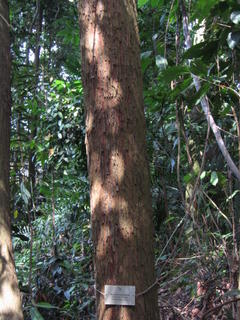
Have fun looking out for the Seraya... Being the most common tree around, it shouldn't be too tough to find! ;)
